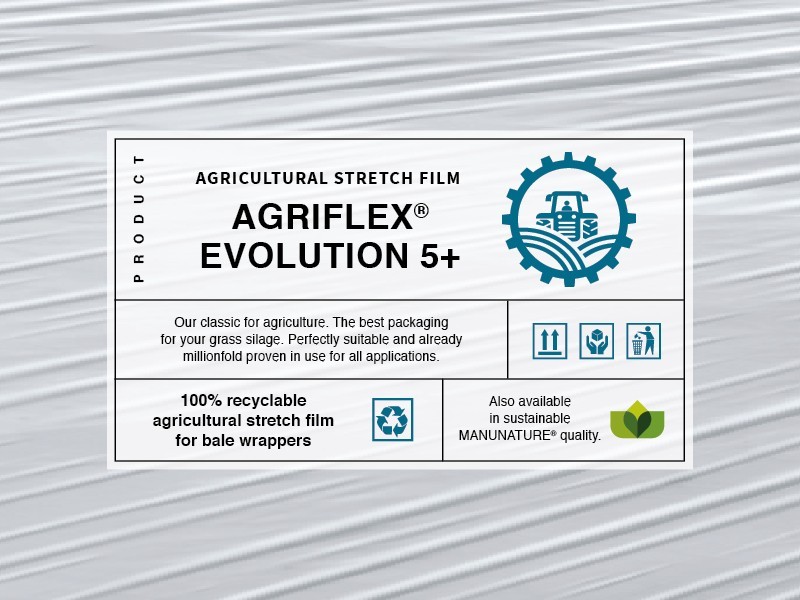AGRIFLEX® EVOLUTION 5+
Typical use: silage baling.
Insufficiently protective packaging jeopardises economic efficiency – especially with regard to feedstuffs in the agricultural industry. Perfect storage of silage and the preservation of its organoleptic properties are an absolute must here. Manupackaging’s extra-strong 100% recyclable stretch film is nothing less than the optimal solution here.


Our proven classic for agriculture. The best packaging for your grass silage. Tested and packed on all models of wrapping machines and wrapping combinations, the AGRIFLEX® Evolution 5+ has proven its optimal reliability a million times.
Benefit from the use of innovative raw materials in optimal composition for maximum reliability.
The latest generation of strong and highly flexible stretch film AGRIFLEX® EVOLUTION 5+ offers numerous applications and is the ideal, low-cost solution for your bale silage.
A natural passion for protection. This is our pledge to you!
Give us a call: +49 3461 7459-974
Send us an email: customercare@manupackaging.com
As founding partner of the ERDE recycling initiative we are strongly committed to support the recovery and recycling system for crop plastics which actively contributes to sustainable agriculture.
Please find here answers to some frequently asked questions from customers using our agricultural stretch films.
Why should I use six layers of film instead of four when wrapping?
For three important reasons that cause an increased load on the plastic in agriculture:
Why should wrapped bales be stored on the flat side instead of on the round side?
About twice as much film is wrapped on the flat side of the bale as on the round side. When the bales are stored on the flat side, this provides more protection to the film, better protection against stubble when the bales are stored in the field, and better protection against the elements (e.g. hail and sun). Furthermore, the bale remains stable and can be easily transported later.
How can I protect my wrapped and stored bales from animals?
Birds and other small animals (e.g. rodents and fallow deer) can cause nearly undetectable micro-holes in the film. Air and moisture can enter the interior of the bale through these almost invisible holes, thereby leading to the formation of mould and incompatible acids.
It is therefore essential to cover and protect the stored bales with special anti-bird nets. These nets can be used for many years and protect the quality of your feed. The net also minimises the effects of solar radiation on the film.
How can I prevent/minimise mould surfaces on predominantly dry silage/feed?
Before the wrapping process, all known parameters (e.g. dry matter content of the feed, number of layers of the film, and pre-stretching) should be checked in accordance with our warranty conditions.
When wrapping dry bales, internal condensation may occur between the film and the feed. This can lead to a discolouration on the surface of the bale. This is usually caused by drastic temperature differences (day/night/day).
The experience of farmers in Northern Europe and the USA has shown that more layers of film (at least twice as many layers as under optimal conditions for dry and moist feed) should be wrapped to prevent/minimise this condensation.
When wrapping dry feed like alfalfa (large stalks containing air), it may well be necessary to use more than double the number of layers (experiences from Northern Europe for dry alfalfa intended for sport horses). This resembles the concept of a double-glazed window in relation to a single-glazed window. Double-glazed windows prevent condensation in the inside of a room. This principle is also applicable to the film.
How can I prevent the excessive reduction of the film width (film too narrow after stretching)?
When you start with the first bale, check the correct reduction in the film width (see below for comparisons).
This test should be performed at least once per day before starting the wrapping process.
If the film is reduced by more than 20% in regular operation, you may need to reduce the speed of the machine in order to counteract the reduction in the film width.
If this is not possible, do not use the machine/film combination under these conditions. Contact the dealer for your machine.
Optimum stretch/wrapper settings:
Effects when the film is overstretched:
What other protective measures should I consider for storage?
The ground on which the bales are stored should also be prepared. Ensure that no large plants components (e.g. stubble) damage/puncture the bales when they are set down. Here, a used silo film can be used on the field as protection.
Immediately seal holes with UV-resistant silo film tape, which is available from most dealers.
If possible, store the bales in the shade to minimise UV radiation. The film thus lasts longer and the feed is not “cooked” as strongly. Cover the bales with protective grilles.
Under no circumstances should you store your bales in a depression. In the case of strong rain or melted snow, they will stand in water, and the feed will spoil. Bales should ideally be stored on a slight gradient so that rainwater is immediately drained away.
Typical use: silage baling.
Typical use: silage baling.
Typical use: silage baling.